The first tour of the new year was an Owl Tour today in North Norfolk. It was a largely grey and gloomy day, even if the sun did threaten to show itself a couple of times, but it was reasonably mild (for the time of year) and with lighter winds than the last couple of days. Not too bad a day for owling!
With the recent clement weather, the local Barn Owls appear to be finding plenty of food at the moment and are not having to work too hard during daylight hours. Still, with an early start, we hoped to catch one out hunting first thing this morning. We made our way straight over to a regular site where one has been seen the last few mornings, but when we arrived there was no immediate sign of it. It wasn’t immediately clear whether it had gone in to roost early today, or was still out somewhere, so we decided to have a walk out along the bank and keep our eyes open.
There were lots of other things to look at here. A Brown Hare was surprising hard to see in the grass until it started running. We could see the black tips to its long ears. Several groups of Brent Geese flew back and forth in untidy flocks, presumably just emerging from their roost out on the saltmarsh. A small party landed down on the grass with a couple of the local Canada Geese where we could get a good look at them.
There were several Marsh Harriers patrolling over the reeds and one of last year’s juveniles landed first on a post and then on a bush so we could get it in the scope, it’s pale head contrasting with its rather uniform chocolate brown body. A couple of Little Egrets flew in, presumably also fresh from their roost site, and landed on the saltmarsh, where two Grey Herons had already taken up position.
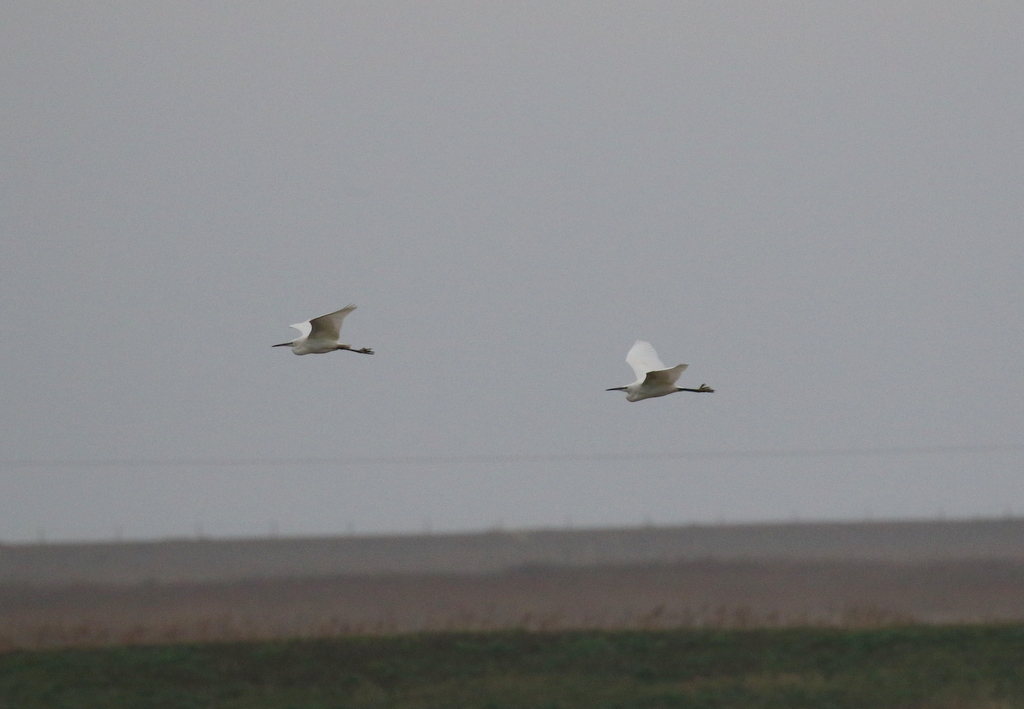
It gradually became clear that the Barn Owl was not going to put in an appearance – it had obviously decided to turn in earlier than it has been doing recently. We decided to move on and try our luck elsewhere. As we walked back to the car, a large flock of Meadow Pipits flew up from the grass and circled round over our heads calling.
It was not particularly auspicious weather for Little Owls, grey and chilly still. Any early hints that the sun might poke a hole through the clouds had faded. Still, we headed inland to have a look. As we pulled up on a concrete pad by the road to scan some barns, something flew up from the muddy puddles in the middle of it. It flashed blackish and white and flew round with flicking wingbeats. It was a Green Sandpiper, a very scarce winter visitor here. Unfortunately it landed again out of view, but it was a very nice bird to see.
At the next set of barns where there are sometimes Little Owls, another quick look failed to find any sign too, but at our third stop we had more luck. Looking across to some distant farm buildings, we couldn’t see one on the roof where they like to sit, but as we scanned across between the barns we could see a lump on top of a pile of wooden pallets. Through the scope, we could see it was a Little Owl.
A footpath runs round behind the barns, so we decided to walk up along it for a closer look. On our way, we stopped to look at a covey of partridges huddled up on the edge of a small copse and their distinctive kidney-shaped dark belly patches identified them as Grey Partridges, much the rarer of our two partridge species. A couple of Yellowhammers flew up out of a cover strip next to the path as we passed and flew off calling.
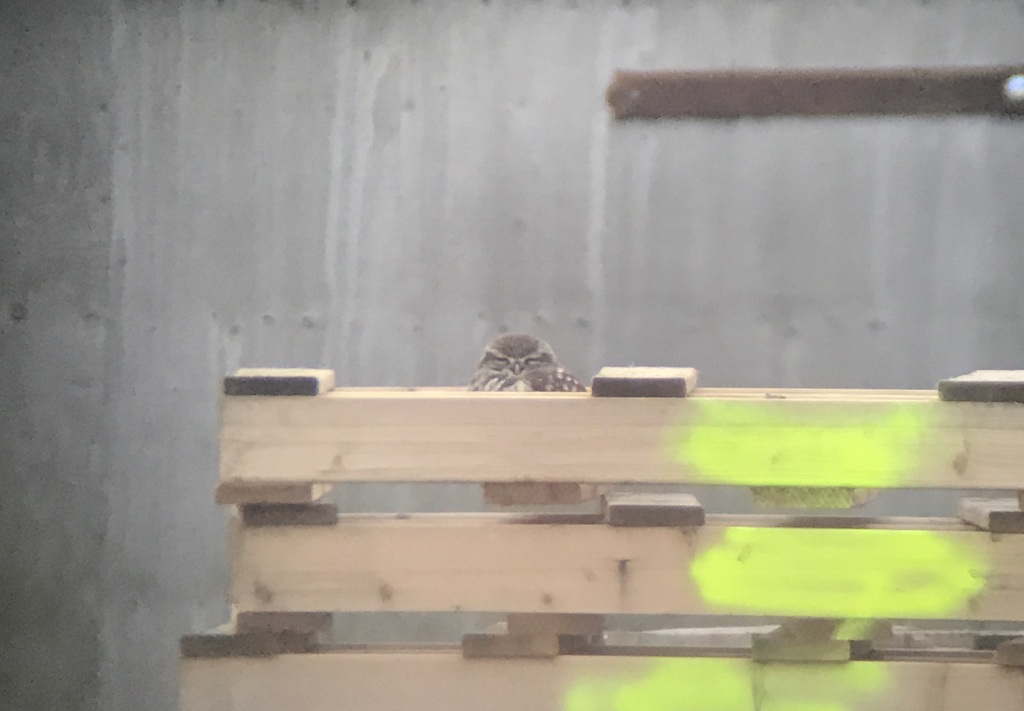
From the footpath, we had a much better view of the Little Owl. It started off facing away from us, so we could see the false eyes on the back of its head, but then it turned to look in our direction and we could see its yellow irises. After a while, it dropped down from the top of the pallets to a spot in between the slats, where we could still see its head and shoulders. It seemed fairly happy with the unusual spot it had chosen to perch in today and appeared to be dozing, with eyes half closed. A large covey of Red-legged Partridges then appeared on the barn roof, where we would normally expect to see the Little Owl!
Back in the car, we meandered our way west. We were ultimately heading for the Wash, but we took an inland route. We did look briefly in passing at a several more Little Owl sites, but we had probably been lucky with the one we had found today. One of the sites where we have seen them in the past is now a building site, as the barns here are being developed into holiday cottages. Unfortunately this is an ever increasing problem, as fewer and fewer old farm buildings are left for wildlife.
We did see a few more different birds on the way, even if the fields were rather quiet today. A Bullfinch flashed out of the hedge ahead of us, flashing its square white rump. Three Red Kites circled lazily over the road. We flushed a Fieldfare out of a berry-laden hawthorn as we passed by.

As we made our way along the path out to the reserve at Snettisham. we stopped to watch a pair of Goldeneye on one of the pits. The female had her neck stretched out in front and held low to the water, possibly in display, although the male next to her seemed to show little interest. A couple of Little Grebes were busy diving a little further on.
Up on the seawall, it was now low tide and a vast landscape of grey mud stretched away ahead of us. With the grey sky above, the whole landscape looked rather uniform. A slightly darker smear across the mud, which could easily be mistaken for part of the grey background, was actually a huge flock of thousands of Golden Plover. Through the scope we could finally make out the golden colour to their upperparts.
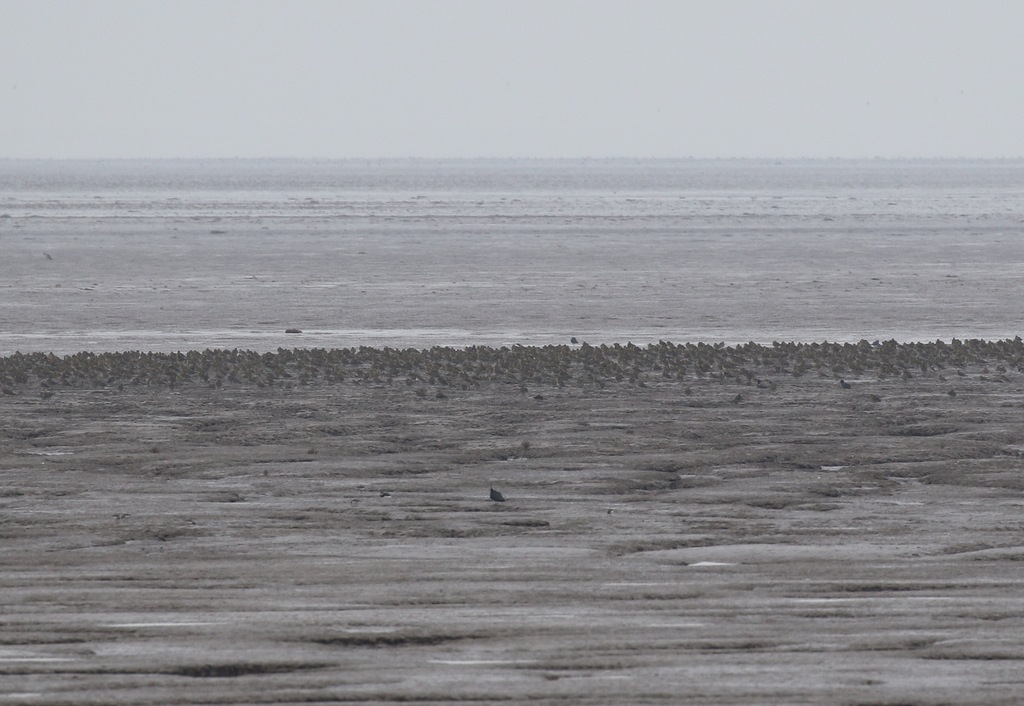
A long line of Teal continued on from the end of the Golden Plover flock and there were lots of Shelducks scattered more liberally and sparsely all over the mud. Scattered groups of Lapwings mostly had their backs to us and looked very dark. Most of the other waders would obviously be out on the waters edge, which was too far off to see today, but we did manage to find a tight group of Knot feeding in the middle distance, much more active, busy than the plovers.
We had a quick look at the north end of the Pits from the causeway. In amongst a noisy gaggle of Greylag Geese and Wigeon, we stopped to look at three more Goldeneye and a different duck surfaced in with them. Small, with a distinctive rusty cap and white sides to the face, it was a ‘redhead’ Smew (a female or first winter male). A scarce winter visitor from northern Europe, this bird has been here for a few weeks now but it very erratic on the Pits, presumably feeding much of the time out on the Wash or on the fishing lakes. Another nice bonus for the day’s list. We watched it for a while as it fed, diving repeatedly.
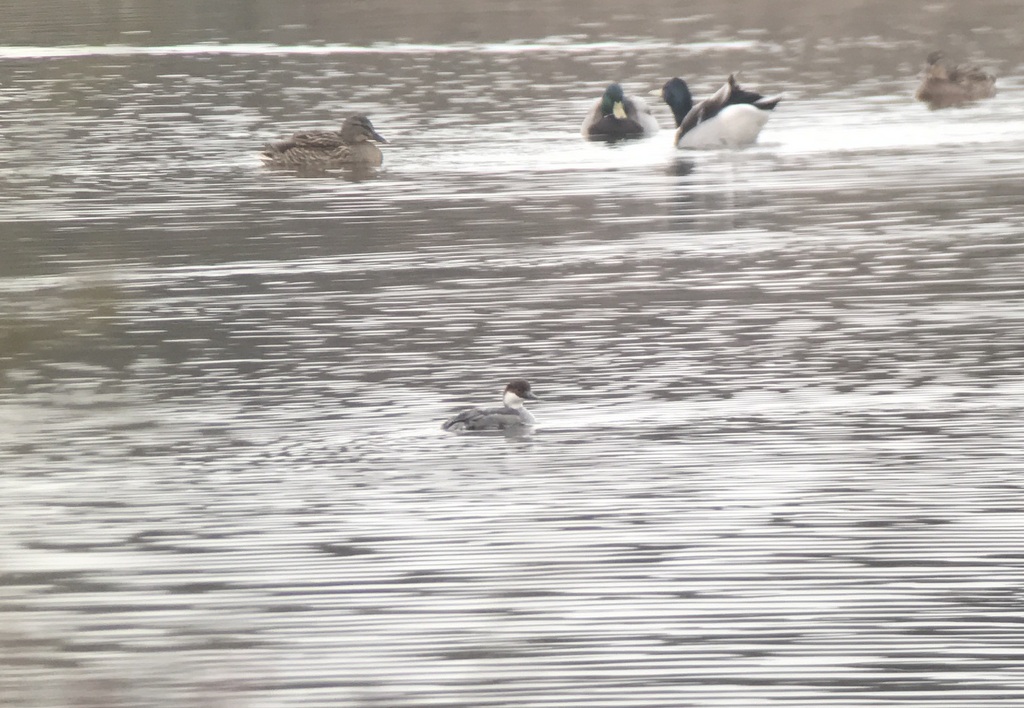
Our real target here was Short-eared Owl. In the middle of the day, we would be lucky to find one out hunting so instead we went to see if we could find one roosting. It didn’t take long to find it, roosting under its usual bramble bush. It was hunched up in the vegetation and almost like it could be stuffed, until it thankfully moved its head just to dispel that suggestion! It looked over towards us and we could see its yellow irises for second before it went back to dozing.
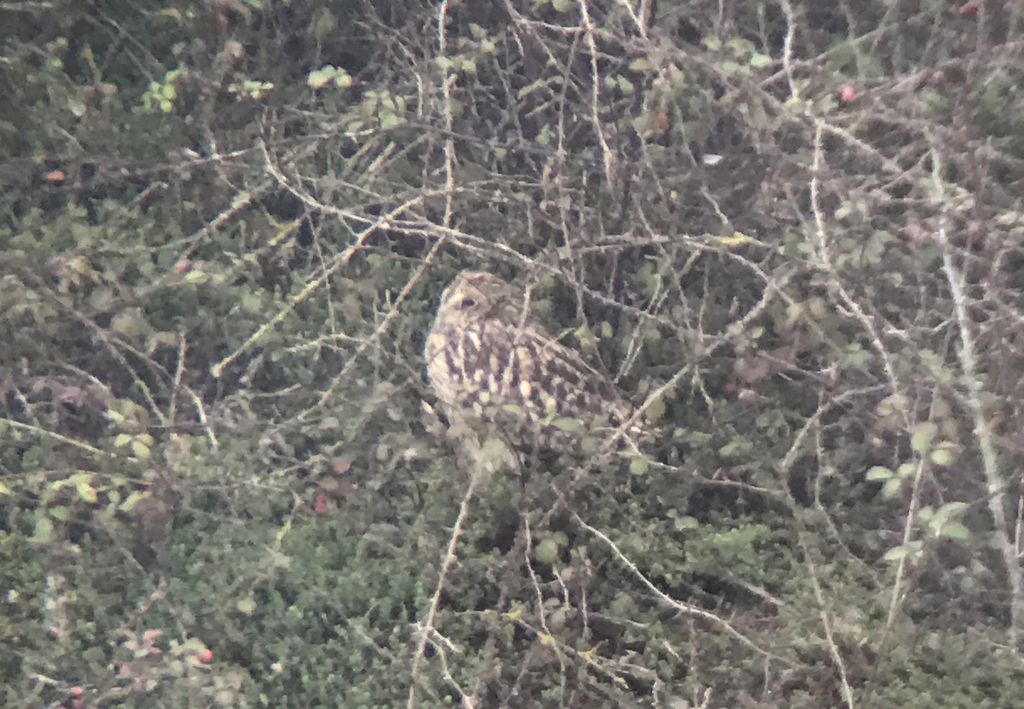
We had a walk round the southern pit to check out the rough grassland surrounding it, but there were no owls out. A feral Barnacle Goose was standing all on its own on the bank. We stopped briefly in South Hide to look at the other end of the Pit, which contained a good number of sleeping Wigeon. We could hear the occasional whistle from them. A couple of Shoveler were tucked up in with them.
A little group of pipits flew up from the bank and in amongst the softer ‘seep, seep’ calls of the Meadow Pipits we could hear the sharper ‘wheest’ call of a Rock Pipit. The latter flew down and appropriately landed on a rock! Then a Meadow Pipit landed on the edge of the water in front of the hide and after picking around on the bank for a minute flew over to join the Rock Pipit, giving us a really nice comparison of the two species together.
It was lunchtime already, so we made our way back to the car for something to eat. As we made our way back along we turned onto a minor road and spotted a commotion on the tarmac right in front. It was a Stoat and it was engaged in a wrestling match with a rather large Brown Rat! The two of them twisted and turned, both seemed to be battling to stay on top.
They writhed across the road and dropped into the shallow gully on the side, so that we could pull up right alongside, just a couple of feet from them. It looked to be a pretty even contest, and after a while the Stoat gave up and disappeared up the bank behind. The Rat paused for a while to recover and then perhaps unwisely went up the bank too.
On our way back east, we stopped in an area of farmland to look at a hedge full of small birds which were flying in and out of a neighbouring cover strip. They were mostly Reed Buntings, but with several Yellowhammers mixed in with them. The birds were flying in and out of the crop all the time, so it was hard to keep up at times. There were a lot more birds down in the vegetation than we could see, as suddenly a large flock of Linnets flew up, circled round, and dropped back in.
Back on the main coast road, as we passed Holkham we could see a huge wave of thousands of Pink-footed Geese coming up off the marshes. We stopped for a look and noticed a long white neck poking out of a ditch out in the grass. It was a Great White Egret – through the scope, we could see its long dagger-shaped bill. A second Great White Egret was feeding on a pool further over.

The Pink-footed Geese disappeared inland over the Park, but there were still lots of geese down on the marshes. In amongst the more numerous Greylags, we found a large party of Russian White-fronted Geese. Through the scope we could see the white feathering surrounding the base of their bills and their distinctive black belly barring. A Goldcrest was singing in the pines nearby.

We had hoped to have a bit more time here, to have a look for hunting Short-eared Owls, but time was getting on and we had an appointment with another owl which we had to keep. We managed to stop for a minute at Wells to watch another huge wave of Pink-footed Geese which were flying in from the fields inland. It was too early for them to head in to roost, so presumably they had just been disturbed from the fields where they had been feeding.
The Barn Owl was not out hunting yet when we arrived. We stood at the gate for a minute and scanned the meadows, then we walked down along the path to where we could see the entrance to the owl box. There was the Barn Owl, perched on the platform on the front of the box – prefect timing! It had just woken up and was trying to work out whether to head out hunting. It still looked sleepy, perched there hunched up with its eyes half closed.

Over the next five minutes or so, the Barn Owl gradually got a bit more active, looking round and opening its eyes. Then silently it dropped from the platform and flew out over the meadow. We were treated to a great display over the next twenty minutes as it hunted. At first it flew round over the long grass, once or twice dropping down after something but coming up empty-taloned.
Then it headed over to the edge of the meadow and landed on a post, where it perched looking down into the grass below. Another great look through the scope. The Tawny Owls were already hooting in the trees beyond now – our next appointment – but we still had a few minutes before they would emerge. The Barn Owl moved around between several different posts before resuming hunting more actively, flying round over the meadow again. As if to bid us farewell, it did one last close fly past, flying across silently right in front of us, even stopping to hover for a second, before heading off. Great to watch!
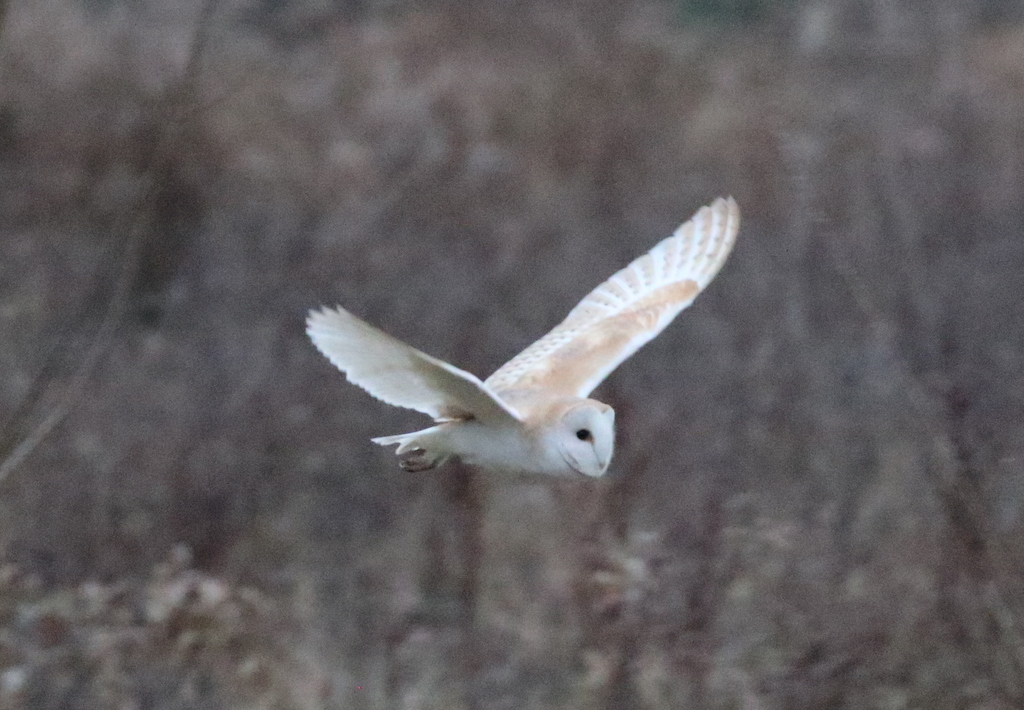
The light was starting to go now, so we headed into the wood. We positioned ourselves where we could see a group of trees clad in dense ivy and waited. We could hear more Pink-footed Geese calling and looked out of the trees to see a series of skeins totalling several thousand birds heading off to roost over the hill beyond.
The Tawny Owl dropped out of the back of the trees unseen tonight – suddenly we could hear it hooting further back in the wood. We followed the path in deeper, but despite hearing it hooting still we couldn’t see it through the branches. We changed position again to try a different angle and then suddenly it flew across the path above our heads, with a sweep of its broad, rounded wings silhouetted against the sky.
It landed, but unfortunately chose the top of a tree covered in ivy where we couldn’t see it. Then it quickly flew back into the wood as we moved to try to get an angle. It was getting dark now, and we could still hear the Tawny Owl hooting from the trees as we walked back to the car. A Woodcock zoomed over the tops of the trees above us in the gloom. Then it was time to call it a night.
















